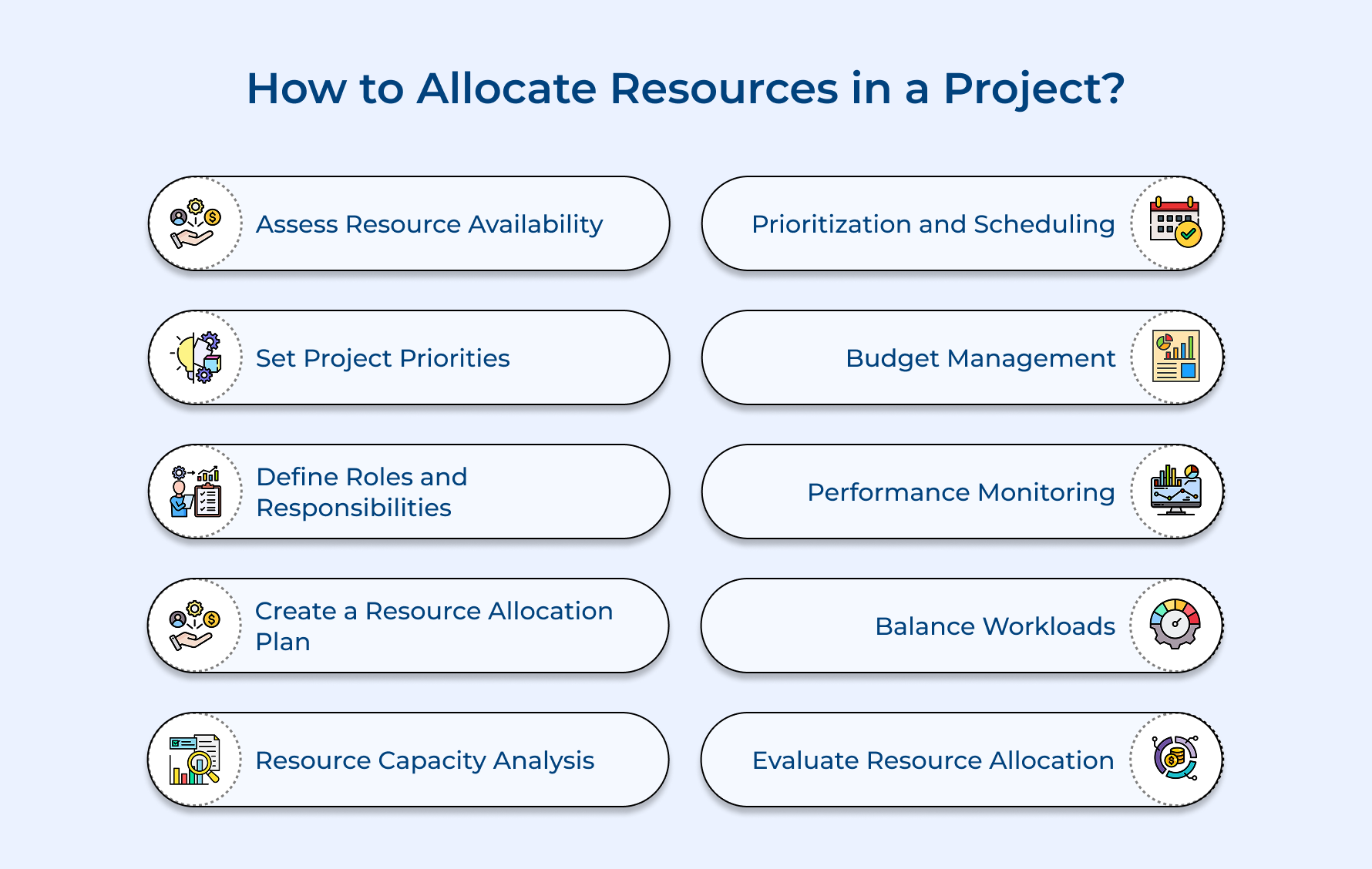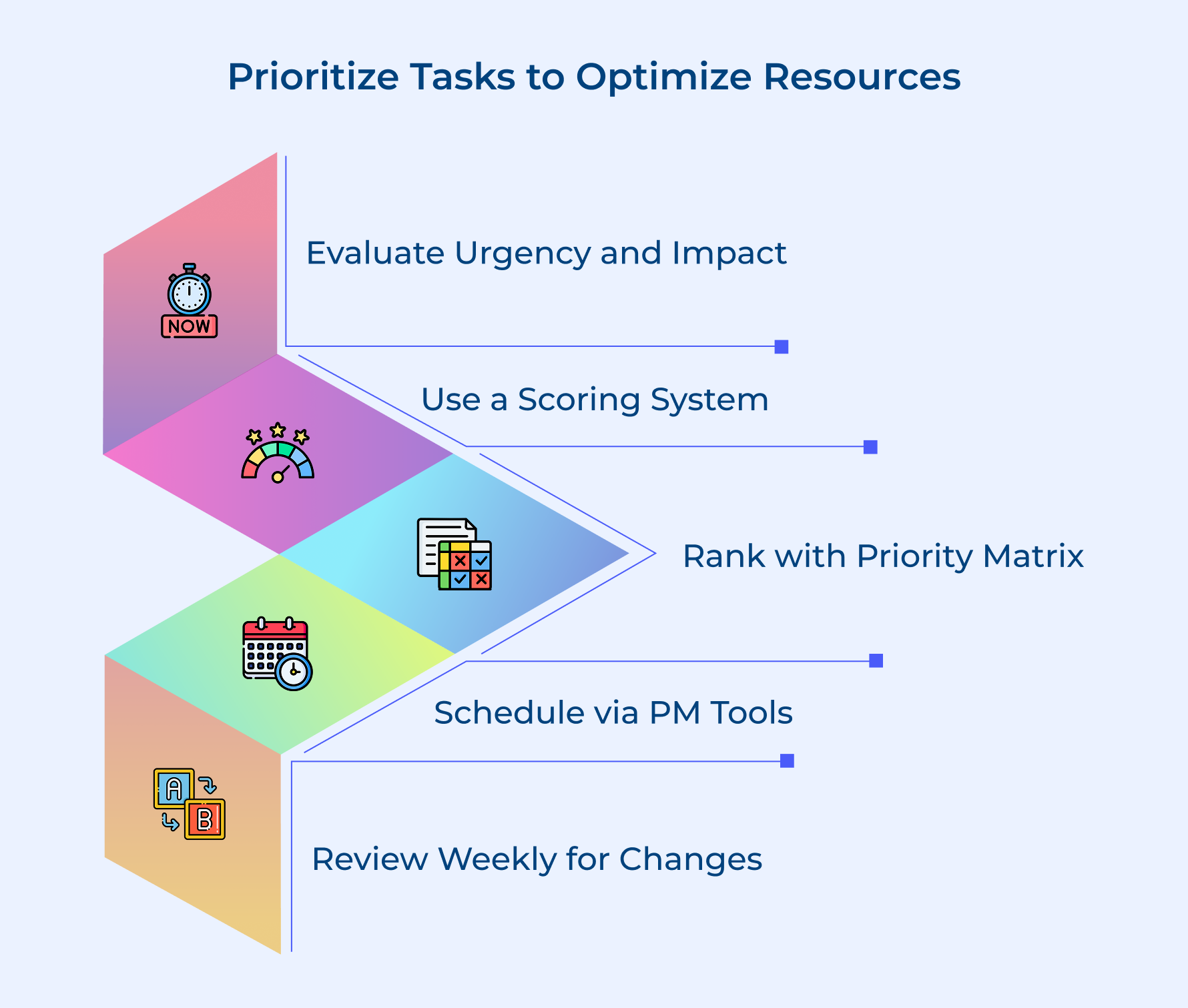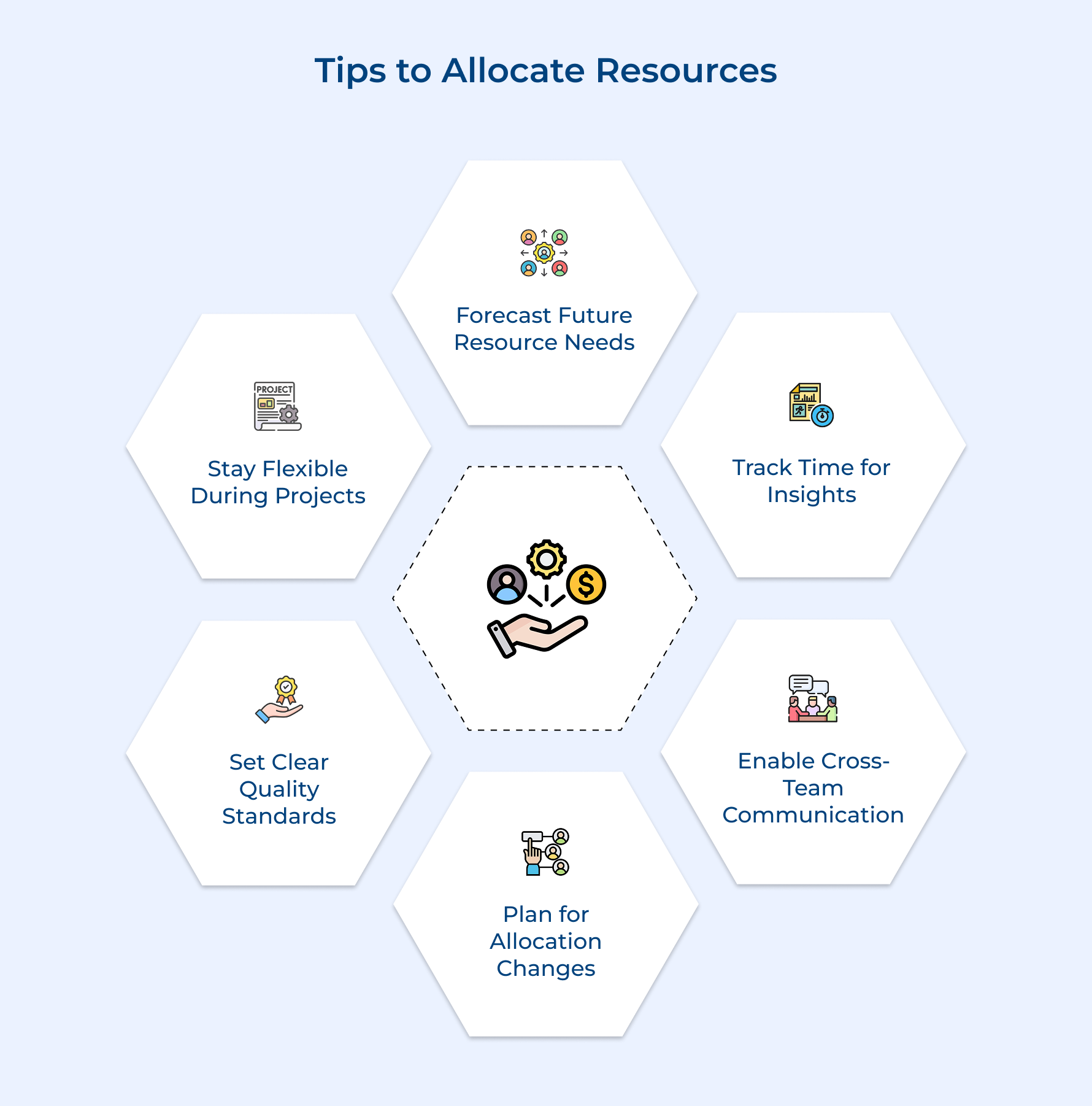What is Resource Allocation & How to Assign it Effectively
- What is Resource Allocation?
- Benefits of Resource Allocation in Project Management
- How to Allocate Resources Effectively in a Project?
- Common Challenges of Resource Allocation
- Tips for Effective Resource Allocation in Project Management
- Drive Business Growth with Effective Resource Allocation
- FAQs about Resource Allocation

Key Highlights:
- Effective resource allocation boosts productivity by ensuring that time, money, and talent are used efficiently.
- Projects can be planned more accurately, avoiding bottlenecks and delays, by assessing resource availability while aligning priorities.
- Regular monitoring and adjusting of resource allocation help maintain flexibility, ensuring resources are used effectively.
Getting the most out of limited resources has become more important than ever, these days. Whether you’re managing teams, budgets, or project deadlines, knowing how to allocate resources effectively can make all the difference in hitting your goals and staying ahead of the competition.
So, how do you ensure you’re using your resources wisely? Join us as we explore resource allocation! It’s key strategies, best practices and real-world techniques to help you optimize resource management as well as drive success.
What is Resource Allocation?
Resource allocation is the strategic process of distributing and managing available resources across various projects, departments, or activities within an organization. These resources typically include money, human capital, physical assets, time, and technological capabilities.
Effective resource allocation ensures that organizations maximize their efficiency and productivity while minimizing waste as well as redundancy. It helps businesses maintain a competitive edge by directing resources to high-priority initiatives that align with strategic objectives.
The key objectives:
- Maximizing return on investment (ROI) by directing resources to projects and activities that generate the highest value relative to their cost.
- Optimizing resource utilization to eliminate waste and ensure resources are neither over-allocated nor underutilized.
- Aligning resource distribution with strategic goals to ensure all organizational activities contribute to long-term success.
Benefits of Resource Allocation in Project Management
Effective resource allocation ensures that time, money, and talent are used efficiently. Let’s explore all the benefits that the process has to offer.
Optimal Use of Resources
When resources like time, budget, and personnel are used wisely, productivity goes up, waste goes down while projects stay on track. It’s all about making the most of what you have!
Enhanced Project Planning
Good resource allocation gives you a clear picture of what’s available, helping you set realistic timelines, goals, and expectations. No more last-minute surprises—just smooth, well-planned execution.
Optimized Resource Scheduling
Nobody likes delays or bottlenecks. By scheduling resources effectively, you avoid conflicts and downtime, keeping everything moving forward without unnecessary hiccups.
Improved Resource Utilization
Ever feel like some resources are overworked while others sit idle? Smart allocation ensures everything and everyone is being used to their full potential—no waste, no burnout.
Faster Project Completion
When resources are where they need to be, tasks get done quicker. That means faster project delivery, happier clients, and more wins for your team.
Supports Scalability
Need to scale up or down? No problem. With efficient resource allocation, adjusting to changing project needs becomes seamless, keeping everything running smoothly no matter what comes your way.
How to Allocate Resources Effectively in a Project?
Allocating resources effectively ensures projects run smoothly, stay on budget, and meet deadlines. Here’s how you can plan a resource allocation strategy for success.
Assess Resource Availability
Before assigning tasks, it’s essential to understand what resources are available and how they can be used efficiently. A clear assessment prevents bottlenecks and delays.
Know What You Have
- Take stock of all available resources—people, budget, equipment, and time.
- Understand their current capacity and workload before making assignments.
Plan Smarter, Not Harder
- A clear resource assessment helps prevent overallocation and underutilization.
- Avoid inefficiencies and delays by ensuring resources are used effectively.
Create a Resource Inventory
- List out all resources and track their availability.
- Match the right resources to the right tasks without overloading or leaving them idle.
Tips:
- Conduct regular resource audits to ensure data is up-to-date and available in real-time.
- Prioritize key project roles to ensure critical resources are allocated first.
Set Clear Project Priorities
Setting clear project priorities is all about knowing what needs to be done first and making sure the most important tasks get the attention they deserve.
When you focus on high-impact tasks early on, you keep things moving smoothly and avoid wasting time on less crucial work. This not only helps meet deadlines but also ensures resources aren’t stretched too thin.
The key is to rank tasks by urgency and importance, tackling what directly impacts project success. And since priorities can shift, it’s essential to review them regularly to stay aligned with overall goals.
Tips:
- Use a priority matrix to evaluate tasks based on urgency and impact.
- Reassess priorities every week to ensure they reflect changing project needs.
Define Roles and Responsibilities
Defining roles and responsibilities is key to making sure every team member knows exactly what they’re responsible for, helping the project run smoothly. When roles are clearly outlined, there’s less confusion and more accountability.
Here’s how to define roles and responsibilities:
- Ensure everyone knows their specific tasks to avoid overlap and confusion.
- Make sure there’s accountability, so each person knows what they’re expected to deliver.
- Use a RACI matrix to clearly define who is responsible, accountable, consulted, and informed for each task.
- Regularly communicate roles and expectations to keep the team aligned.
Tips:
- Use a RACI matrix to document and communicate team roles.
- Regularly review roles to ensure they are aligned with changing project needs.
Create a Resource Allocation Plan
A resource allocation plan is a roadmap that shows how resources like time, budget, and personnel are distributed across tasks as well as timelines. It ensures that every phase of the project has the right support to move forward.
The plan brings structure and transparency, making sure resources are used efficiently while tasks are completed on time. With a clear allocation, you avoid resource shortages or conflicts.
Stay on track by developing a plan that aligns resources with project timelines, and use project management software to adjust as things evolve.
Tips:
- Create a visual resource allocation chart for better clarity.
- Schedule weekly reviews to assess if the allocation plan is working effectively.
Resource Capacity Analysis
Resource capacity analysis is about understanding how much work your available resources can handle, factoring in skills, time, and other commitments. It prevents overloading team members, ensuring optimal resource use without risking burnout.
If needed, use capacity planning tools to track availability and demand, and create visuals to spot gaps. Regular check-ins help assess if adjustments or reallocations are necessary to keep things running smoothly.
Tips:
- Develop a capacity dashboard that shows real-time resource utilization rates and alerts for over-allocation situations.
- Conduct bi-weekly capacity planning meetings with the team leads to adjust allocations based on actual versus planned utilization.
Prioritization and Scheduling
Prioritizing tasks is all about evaluating what’s most important, urgent, and aligned with your overall strategy. Ranking them helps you allocate resources more effectively, ensuring the most critical tasks are tackled first.
This approach helps prevent resource conflicts, manages competing demands, and keeps the project on track with its timelines.
Create a prioritization matrix to rank tasks by urgency and importance.
Use project management software to schedule resources based on these priorities.
Regularly review and adjust priorities as business needs change to stay on target.
Tips:
- Implement a scoring system (1-5) for project prioritization considering factors like strategic value, ROI, and urgency.
- Create a weekly priority review process to adjust resource allocations based on changing business needs and emergent tasks.
Budget Management
Managing a project budget effectively is all about planning, tracking, and controlling financial resources to make sure costs don’t spiral out of control. It also gives you the flexibility to make informed decisions about where to allocate resources and where you can save money.
1. Track Budget Regularly
- Use budget tracking tools to monitor expenses and ensure you’re staying within limits.
- Conduct regular financial reviews to spot potential issues early.
Create Cost-Performance Indices
- Develop metrics to measure how well resources are being utilized compared to costs.
2. Set Automated Alerts
- Set up alerts for any budget variances to stay on top of unexpected expenses.
Conduct Cost-Benefit Analyses
- Periodically analyze the costs versus benefits to ensure your project is on track financially.
Tips:
- Establish monthly budget review meetings with stakeholders to analyze variances and adjust resource allocations accordingly.
- Create a real-time budget dashboard that tracks resource costs against allocated budgets with automatic alerts for overruns.
Performance Monitoring
Tracking and evaluating resource performance is essential to ensure everything is on track while also running efficiently. Here, you can spot any performance gaps, identify top performers, and make informed decisions about where to allocate resources next. Here’s how to do it:
- Implement KPI tracking systems to measure key performance indicators and monitor progress.
- Use data analytics tools to assess productivity and efficiency across the board.
- Set up performance dashboards for real-time updates, helping you keep track of everything as it happens.
- Regularly review performance to identify opportunities for improvement or reallocation.
Tips:
- Create monthly performance scorecards that track key metrics like utilization rate, task completion time, and quality metrics.
- Implement a peer review system for resource performance evaluation with quarterly assessments.
Balance Workloads Among Team Members
Balancing workloads is crucial for maintaining a healthy and efficient team. Distributing tasks evenly helps prevent burnout and ensures that no one is overwhelmed.
When team members are overworked, it can lead to mistakes, delays, or inefficiencies that affect the project’s success. By assigning tasks based on each person’s capacity and skill set, you ensure that everyone can contribute effectively.
Regularly checking in on workloads while redistributing tasks when needed helps maintain a balanced workload, making sure everything gets done on time and to the highest quality.
Tips:
- Use time-tracking tools to gauge individual workloads and adjust as needed.
- Schedule weekly team check-ins to ensure everyone’s workload is balanced.
Evaluate Resource Allocation Post-Project
Post-project evaluation is an important step in understanding how well resources were allocated and where things can be improved for next time. Once a project wraps up, assessing how resources were distributed helps highlight both successes and areas that need adjustment.
Gathering team feedback and reviewing resource usage can offer valuable insights, allowing you to fine-tune your approach for future projects. It helps improve planning, execution, and overall project success moving forward.
Tips:
- Conduct a project debrief with the team to discuss resource allocation.
- Document lessons learned and apply them to future resource planning strategies.
Common Challenges of Resource Allocation
Resource allocation can be tricky, with various challenges that can affect project outcomes. Identifying these common hurdles helps in finding effective solutions and ensuring smoother project execution.
Resource Scarcity
Organizations frequently face the challenge of insufficient resources to meet all project demands simultaneously. Address this by implementing a clear prioritization framework based on strategic value and ROI. Develop strategic planning for critical resources, consider outsourcing non-core activities, and maintain a flexible resource pool.
Poor Resource Planning
Inadequate planning often leads to resource conflicts and inefficient allocation. The solution lies in implementing robust project management software to track the availability of resources and utilization. Conduct regular resource forecasting meetings, maintain updated resource calendars, and establish a centralized resource management system.
Dynamic Project Requirements
Changing project needs can disrupt resource allocation plans. Maintain flexibility by building buffer time into schedules, using agile resource management approaches, and regularly reviewing as well as adjusting resource plans. Implement change management procedures to assess the impact of requirement changes on resources.
Technology Limitations
Outdated or inadequate resource management tools can hinder effective allocation. Invest in modern resource management software, ensure proper integration with existing systems, and provide adequate training to users. Regular system updates and maintenance help maintain efficient resource tracking as well as allocation.
Skill Mismatches
Assigning resources without proper consideration of skills as well as expertise can impact project quality and timelines. Create detailed skill matrices and maintain updated resource profiles. Invest in training programs to develop versatile team members, implement mentor-mentee programs, and regularly assess skill gaps to ensure appropriate resource deployment.
Tips for Effective Resource Allocation in Project Management
Effective resource allocation is key to project success, ensuring that time, budget, and talent are used efficiently. Here are some tips to help you allocate resources wisely while keeping your projects on track.
Resource Forecasting
To stay ahead of future demands, use forecasting methods to predict your resource needs. By analyzing historical data and leveraging predictive analytics, you can plan better. Regularly reviewing forecasts helps avoid resource shortages and keeps you prepared for what’s coming next.
Implement Time Tracking
Time tracking gives you a clear picture of how resources are being used. The data reveals productivity patterns, helps identify bottlenecks, and makes future resource planning more accurate, based on past performance.
Ensure Effective Communication Across Teams
Keeping communication open and clear between teams is crucial for managing resources. Regular check-ins help set expectations, resolve conflicts, and keep everyone updated on resource availability as well as any changes in allocation.
Change Management
Resource allocation often needs to change throughout a project, so it’s important to have processes in place for handling these changes. Proper communication, documentation and clear procedures for requesting as well as approving adjustments help keep things stable.
Quality Assurance
Set quality standards for how resources are allocated to ensure they meet project requirements. Regular quality checks help maintain high standards and prevent any issues related to resource allocation from affecting project outcomes.
Adjust Allocations as Projects Evolve
As projects progress, priorities and challenges can shift, so it’s essential to stay flexible as well as adjust resource allocations accordingly. Being adaptable ensures that the project stays on track, even when the scope or direction changes.
Avoid Over-allocating Resources
It’s important not to over-allocate resources, especially when it comes to personnel. Overloading team members can lead to burnout and reduced productivity. Keeping resource allocation within reasonable limits ensures long-term efficiency and prevents unnecessary stress.
Drive Business Growth with Effective Resource Allocation
Effective resource allocation is key to successful project execution. Careful assessment of available resources, setting clear priorities, and remaining adaptable ensures that resources are used efficiently to meet project goals.
Regular monitoring and open communication help track resource usage while also allowing for necessary adjustments. Proactively managing resources prevents waste and delays, ensuring that the project stays on track as well as within budget.
Thoughtful resource allocation leads to improved productivity, reduced costs, and timely project completion, driving overall success while contributing to organizational growth.
Limit time — not creativity
Everything you need for customer support, marketing & sales.
Neeti Singh is a passionate content writer at Kooper, where he transforms complex concepts into clear, engaging and actionable content. With a keen eye for detail and a love for technology, Tushar Joshi crafts blog posts, guides and articles that help readers navigate the fast-evolving world of software solutions.



